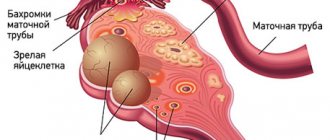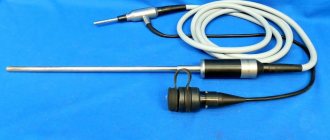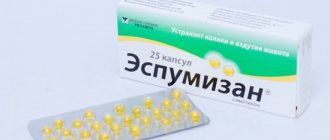There are contraindications. Specialist consultation is required.
Polycystic ovary syndrome PCOS causes ovulation disorders and infertility. If conservative therapy is not effective within 4-5 cycles, surgical treatment methods are used. They are aimed at reducing the volume of luteal tissue - a thickened capsule and/or an enlarged ovarian body. As a result, the production of androgens decreases, the woman’s hormonal levels are normalized, and she becomes able to conceive and bear a child.
Modern medicine gives preference to laparoscopic techniques for performing operations for polycystic disease - without abdominal incisions in the abdominal cavity, access through microincisions. Manipulations are performed under the control of a video camera. The patient is discharged from the hospital the next day. Depending on the clinical picture of PCOS, different surgical techniques are used.
Wedge resection is the excision of pathologically altered tissue of the ovarian capsule in the form of triangular incisions. Intervention is indicated for a significant increase in ovarian volume and prolonged absence of ovulation. The volume of the organ decreases to normal size, the physiological production of hormones is restored. If the process affects part of the ovary, it is excised, leaving healthy tissue.
Electrothermocoagulation , or drilling, is the cauterization of cyst walls using an electric knife or an electrocoagulator. Allows you to coagulate blood vessels after tissue separation and avoid the need for sutures. Characterized by the absence of blood loss.
Decortication is the removal of the thickened capsule of the ovary affected by polycostal disease, followed by puncture of the follicles. The edges of the cysts are sutured. The removed tissues are sent for histological examination.
Cauterization - 6-10 incisions with a diameter of up to 2 mm and a depth of up to 1 cm are made along the entire rounded surface of the ovary with a monopolar electrode. An ultrasonic scalpel or laser is often used. The operation allows the follicle to rupture during ovulation to release the egg. Intervention is indicated for a slight increase in ovarian volume in young women.
Laparoscopic method
General anesthesia
Operation time - 1 hour
Recovery in hospital - 2-3 days
Cost of the operation: from 26,000 rubles.
Nature of pain
Many women are not even aware that they have a cyst until they undergo a medical examination or develop complications. But sometimes, as the formation develops, a feeling of discomfort in the abdomen may appear in the early stages. This indicates the presence of irritated nerve nodes and pressure on the bladder.
As the formation grows, early pain occurs. With an ovarian cyst, the side hurts, it swells, increases in size, and the sensation of discomfort is constant. This is due to the fact that the formation presses on the wall of the abdominal cavity.
As the disease progresses or complications occur, a woman may notice severe discomfort, a feeling of squeezing, bursting from the inside. If such sensations appear, you should immediately consult a specialist.
Different types of cysts manifest themselves differently, and symptoms may also vary:
- Follicular. It causes virtually no pain. It manifests itself in the form of discomfort or nagging pain on the side where the formation occurred.
- Cystic formation of the corpus luteum. This form of cyst has almost no effect on the condition and does not cause pain. When localized on the right, discomfort may appear in that area.
- Dermioid. Causes intense pain at the location. This is due to the fact that the formation can greatly increase and affect the functioning of other organs.
- Muciotic. Benign formation with a tendency to malignancy. The pain is increasing in nature and radiates to the legs. As the formation grows, neighboring organs and tissues suffer.
- Endometriotic. Develops as a complication of endometriosis. With such an ovarian cyst, the lower abdomen hurts, problems with bowel movements arise, and convulsions and seizures may occur.
With polycystic disease, which is characterized by the development of several formations at once, severe nagging pain occurs. They are localized in the abdomen, in its lower part, and almost never stop. With prolonged growth of functional cysts and lack of proper treatment, hemorrhagic formations can occur. They are characterized by nagging pain that intensifies in the period before menstruation. At the same time, menstrual bleeding itself becomes more abundant.
Localization: where it occurs
The location of pain depends on several factors. A particularly strong influence is exerted by:
- Associated inflammatory processes.
- Dimensions of education.
- Complicated course.
The first manifestations are usually noted on the left or right in the lower abdomen. Most often, cysts develop on the right, which is explained by the peculiarities of the female ovaries; in this case, their manifestations are confused with appendicitis. If the formation grows quickly, then the pain becomes wandering in nature.
Most often, discomfort can be observed in the area:
- Breasts. The appearance of unpleasant sensations in the chest area is characteristic of a corpus luteum cyst.
- Lower back. Localization in this area often indicates rapid growth of formation and a high probability of rupture.
- Lower abdomen. The appearance of discomfort indicates the progression of the pathology and an increased risk of complications.
- Left or right side with discomfort in the leg. Localization of pain on the left or right indicates the location of the formation, and unpleasant sensations in the leg indicate compression of the vessels of the hip area.
- Rectum. Unpleasant sensations indicate that the formation has grown significantly and is affecting the functioning and blood supply of neighboring organs.
- Sacrum. Pain indicates the progression of the disease and the presence of complications.
Only a doctor can make an accurate diagnosis, determine the type of cyst, its location and possible complications after conducting a thorough diagnosis.
Menstruation after hysteroscopy
The first menstruation after hysteroscopy can begin in 25-50 days. A woman should pay attention to the nature of the discharge. If they become abundant, and their color or consistency changes, this may be a sign of a pathological process in the uterine cavity. The pungent smell of the first menstruation after hysteroscopy usually indicates inflammation in the uterine cavity, and in combination with the black color of the discharge, it often indicates endometriosis. If surgery was performed during hysteroscopy, then this day is considered the first day of menstruation. After hysteroscopy, the first menstruation lasts longer than usual. The reason for this is damage to the endometrium.
If you need to perform a hysteroscopy, please contact the IVF Center clinic in Yekaterinburg. Our procedures are carried out by experienced specialists who have extensive experience in performing diagnostic and surgical procedures. We provide care to patients with many gynecological diseases and monitor them in the postoperative period.
Causes of pain
If an ovarian cyst hurts, this most often indicates the occurrence of a number of problems or complications of the condition. If you ignore the gynecologist's recommendations, discomfort may appear during:
- Active sex.
- Excessive physical activity.
- Injuries and impacts to the pelvic area.
If a woman followed all the recommendations, then the appearance of pain may indicate:
- Changing capsule sizes.
- Cyst rupture.
- Twist the legs.
These conditions require emergency intervention and constant medical monitoring, so if discomfort occurs, you should immediately seek help.
Physical procedures
Painful sensations can be caused by physiotherapeutic treatment, only in rare cases. The cyst may remind itself after undergoing a magnetic therapy procedure, but only if the woman resorted to self-medication and underwent the procedure without consulting a gynecologist.
Physiotherapeutic treatment does not act as an independent method, but is used only in combination with other methods. Typically, such procedures are resorted to during the rehabilitation period to prevent the formation of adhesions, normalize blood circulation, and stabilize hormonal levels.
Indications and contraindications for hysteroscopy
Diagnostic hysteroscopy is performed if the following uterine pathology is suspected:
- endometrial polyp;
- adenomyosis;
- submucous uterine fibroids;
- intrauterine constrictions;
- endometrial hyperplasia;
- various defects in the anatomical structure of the uterus;
- suspicion of perforation of the uterine wall or the presence of a foreign body in its cavity;
- suspicion of malignant neoplasm;
- signs of intrauterine fistula;
- algodismenorrhea;
- synechiae in the uterine cavity.
Quite often, such an examination is prescribed for infertility. Hysteroscopy on the eve of in vitro fertilization allows you to assess the condition of the uterus, identify pathologies that may interfere with embryo implantation, and verify the physiological readiness of the organ for the IVF procedure. Relative indications for hysteroscopy may include irregular menstruation, bleeding from the genitals, miscarriage and the need to monitor the effectiveness of hormonal therapy.
Surgical hysteroscopy is performed for polyps of the uterus and cervical canal, myomatous nodes located in the submucosal layer of the myometrium, and adenomyosis. It is carried out to remove remnants of the intrauterine device, fertilized egg, and foreign bodies. Another effective treatment method that minimizes damage to uterine tissue is laser ablation, which is also performed using a hysteroscope.
If there are the following contraindications, performing hysteroscopy is unacceptable:
- cervical stenosis;
- heavy uterine bleeding;
- acute inflammatory diseases of the female genital organs;
- pregnancy;
- malignant neoplasms of the cervix;
- third and fourth degrees of vaginal purity.
If you perform hysteroscopy, neglecting the fact that there are contraindications, then serious complications may develop after it, which are unsafe for the woman. In this case, menstruation after hysteroscopy may come late or be excessively heavy.
How to relieve pain before going to the medical center
If pain with a left ovarian cyst greatly affects the quality of life, then before contacting a specialist, you can use painkillers. Painkillers are most often used in combination with antispasmodics:
- Ibuprofen.
- No-shpa.
- Paracetamol.
- Spazmolgon.
Additionally, you can use sedatives that will reduce the intensity of pain and help relax the muscles. In some cases, it is possible to use a heating pad, which is placed at the location of the cyst. This allows you to relieve spasm and further relax the muscles.
But you should not resort to self-medication and simply dull the pain. Based on the strength and nature of the manifestations, the doctor can determine:
- The patient's condition.
- Presence of complications.
- Localization of the cyst.
When pain is dulled by taking medications, this diagnostic method becomes ineffective, so immediately before visiting a doctor you should stop taking pills.
Urgent medical care
When diagnosing a tumor, it is very important to visit your doctor regularly. Cyst rupture, leg torsion and malignancy require emergency medical care and hospitalization. When torsion or rupture occurs, the following symptoms occur:
- Ovarian cyst colitis.
- Painful sensations intensify and become more intense.
- The area where the formation is located increases in size and swells.
- After sudden movements or intimacy, the pain intensifies and is pulsating.
- Discomfort spreads from the lower abdomen to the lumbar region and sacrum.
- There is a feeling of weakness, vomiting is possible.
- Body temperature rises.
If such symptoms appear, you should immediately consult a doctor. As a rule, the specialist insists on hospitalization and performs diagnostic laparoscopy. If necessary, the complication can be removed immediately. The recovery period after laparoscopic intervention is 5 days.
If a woman arrives in serious condition, abdominal surgery with removal of the ovary may be required. In this case, the recovery period will be from 1 to 2 weeks, depending on the complexity and volume of the intervention.
Pregnancy after laparoscopy: when is conception possible?
- fabrics do not come into contact with gauze swabs, gloves, or air;
- short rehabilitation period (the woman is discharged within 2-3 days);
- almost complete absence of pain (usually after surgery, only distension of the abdomen is felt until the gas leaves it);
- neat, invisible puncture holes instead of rough scars;
- low risk of adhesions;
- simultaneous diagnosis and surgical treatment;
- the ability to immediately detect and prevent bleeding, cauterize erosion, etc.
- The disadvantages of the method include the need for anesthesia, which can cause some complications. Also, the operation should be performed by a surgeon with experience in this particular area. Laparoscopy is not performed in the presence of large tumors or during manipulations involving suturing of blood vessels.
Indications for laparoscopy
Endoscopic surgery can be performed on a planned or emergency basis. Indications for laparoscopy are:
- cystic ruptures;
- necrosis of the myomatous node;
- obstruction of the fallopian tubes;
- ectopic pregnancy;
- twisting of the pedicle of a cystic formation in the ovary;
- inflammatory purulent pathologies of the appendages;
- torsion of the node due to fibroids;
- tubal ligation;
- temporary sterilization with clips;
- uterine fibroids;
- various neoplasms;
- secondary form of amenorrhea;
- genital endometriosis;
- small cancerous operable tumors;
- polycystic disease;
- appendicitis;
- the presence of adhesions;
- removal of the ovary (or both) or the uterus.
Laparoscopic surgery is also performed for pain (of unknown etiology) in the pelvic area, as a treatment for infertility. Some types of surgery can also be performed during pregnancy. Laparoscopy is often preferred.
Recovery period
After the operation is completed, you may experience some bleeding that resembles menstrual bleeding. They can last up to 3 weeks, but usually end after 7 days. Laparoscopy is performed on days 7-10 of the cycle and there are no problems with the menstrual schedule, although they may simply shift by a few days.
After the operation, several almost invisible scars remain. Over time, they completely disappear. Doctors do not advise having sex before the second cycle to exclude possible infections and tissue damage. There are no problems with ovulation. It should be noted that the cycle can be anovulatory twice a year, this is normal.
Chances of conception
The chances of pregnancy after laparoscopy mainly depend on various factors - the disease and its severity, complications during the recovery period, the woman’s age and ovulation.
Laparoscopy helps to significantly increase the chances of conception. The operation is low-traumatic and has quick recovery. After eliminating the cause that was an obstacle to conception, women often become pregnant within the first two months.
Advantages of MC “HEALTHY FAMILY”
WE USE ONLY EUROPEAN, AMERICAN AND SOUTH KOREAN DRUGS ALL DRUGS ARE CERTIFIED YOUR COSMETOLOGIST HAS ABOUT 30 YEARS OF EXPERIENCE LOW PRICES FOR 100% US WE HAVE BEEN WORKING FOR COSMETOLOGICAL SERVICES OVER 1000 PATIENTS SINCE 2006 LOW COST OF BOTOX FROM 200 RUB. PER UNIT WE PROVIDE MORE THAN 5,000 COSMETOLOGY PROCEDURES PER YEAR
Cost of treatment for ovarian cysts
Ovarian cysts are a fairly common disease, which, despite a favorable course, can lead to a number of serious complications. To maintain women's health and diagnose as early as possible, you need to regularly visit a gynecologist and undergo preventive examinations.
With early diagnosis, specialists prescribe conservative treatment followed by physical therapy, but if large formations are detected, a tendency towards malignancy or other complications, surgery may be required. The cost of treatment depends on:
- Forms of education.
- Conditions of a woman.
- Presence of complications.
- The chosen treatment method.
You shouldn't skimp on your health. Contact qualified gynecologists and forget about living with pain.
Probability of polycystic disease recurrence
A year after surgical treatment of PCOS, the likelihood of becoming pregnant decreases. Recurrence of clinical symptoms in most patients is observed after 5 years. Therefore, after childbirth, in order to exclude hyperplastic - precancerous - processes, oral contraceptives of the latest generations are prescribed. This group of drugs helps reduce the production of androgens and in the vast majority of cases does not have negative side effects.
To clarify the details of surgical treatment of polycystic disease and prices for operations in St. Petersburg, contact us in any convenient way.









